Abstract
The association of class I and II HLA antigens with rheumatic fever and its manifestations was examined in 72 patients, including 48 blacks and 24 Caucasians. No significant association was found between class I antigens and rheumatic fever. In contrast, HLA-DR2 and HLA-DR4 phenotypes were encountered in a significantly higher frequency in black and Caucasian patients with rheumatic fever, respectively, compared with the control populations (P less than 0.005). The most significant association (P less than 0.005) of these DR antigens with a major manifestation of rheumatic fever was found for mitral insufficiency. In addition, a significant association was encountered between persistent elevation of antibody to the group A streptococcal carbohydrate and HLA-DR4 in Caucasian patients (P less than 0.04) or HLA-DR2 in the black patients (P less than 0.001). The frequency of HLA-DR2/4 heterozygotes among patients with rheumatic fever did not differ significantly from controls. These findings support the concept of a genetically determined susceptibility to rheumatic fever and, particularly, to rheumatic heart disease. The association of the clinical manifestations of rheumatic fever and the immune hyperresponsiveness to a streptococcal antigen could be ascribed to a disease-associated immune-response gene which is in linkage disequilibrium with the DR2 and DR4 alleles of HLA-DR locus on chromosome six.
Full text
PDF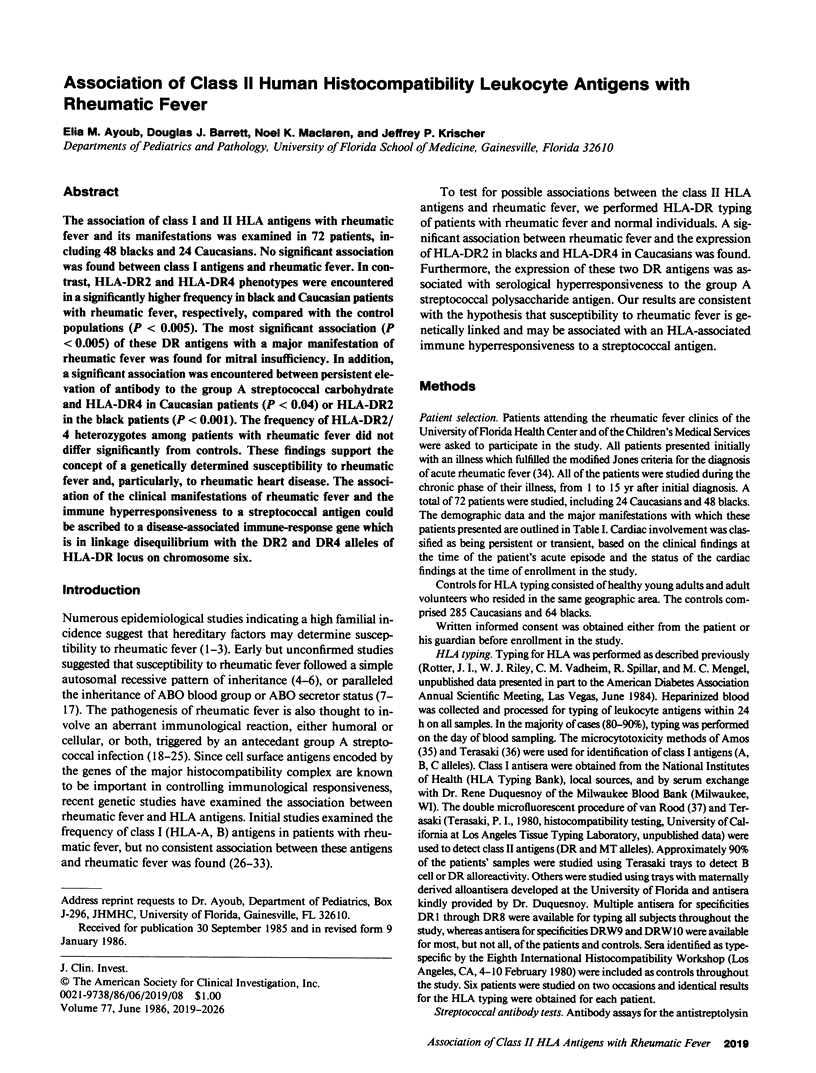
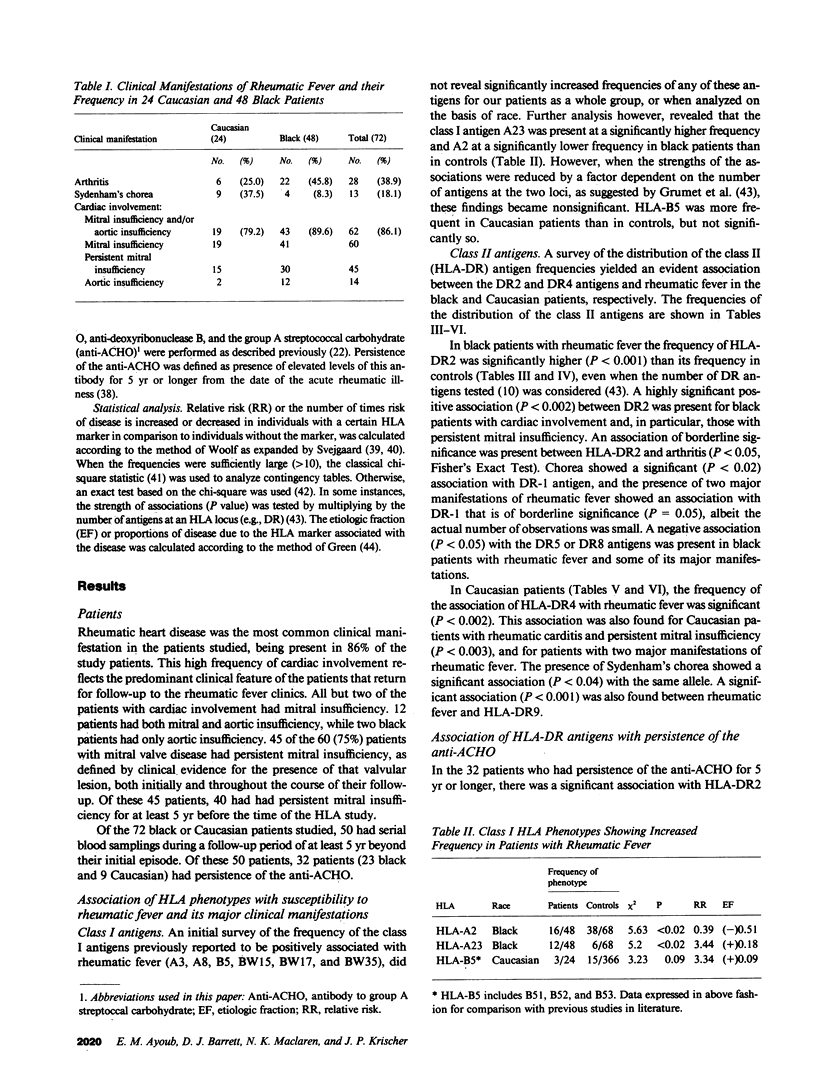
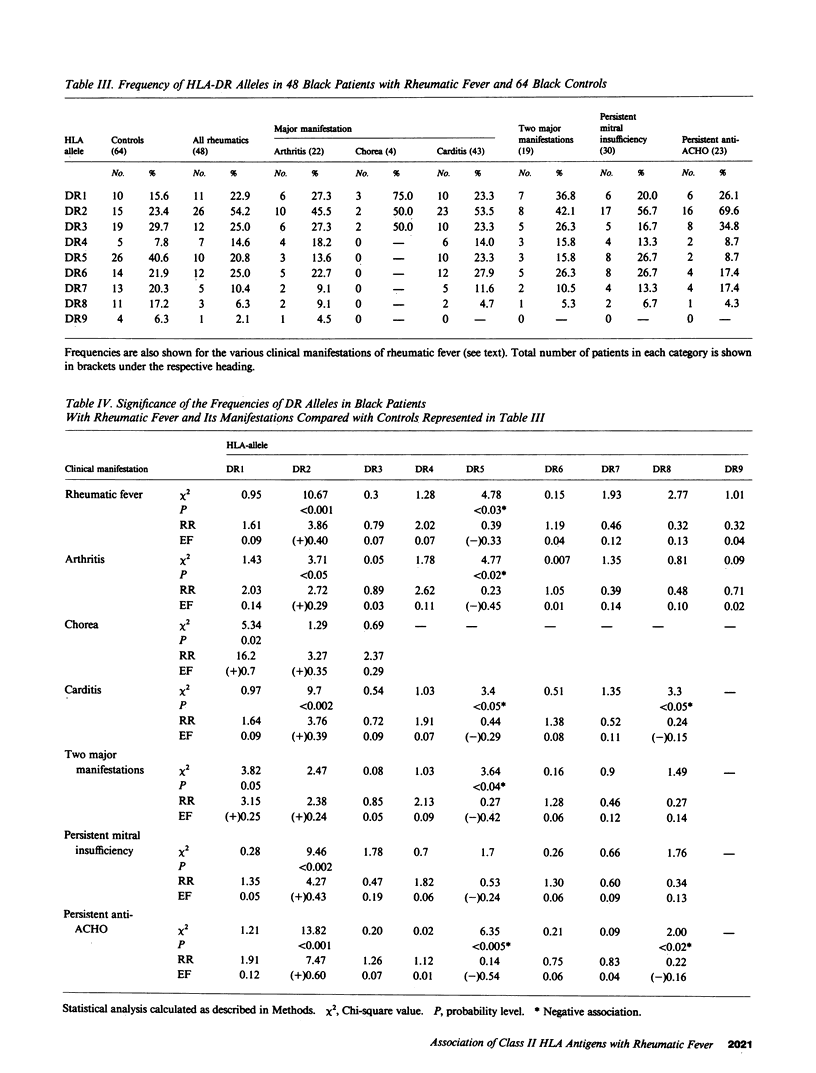
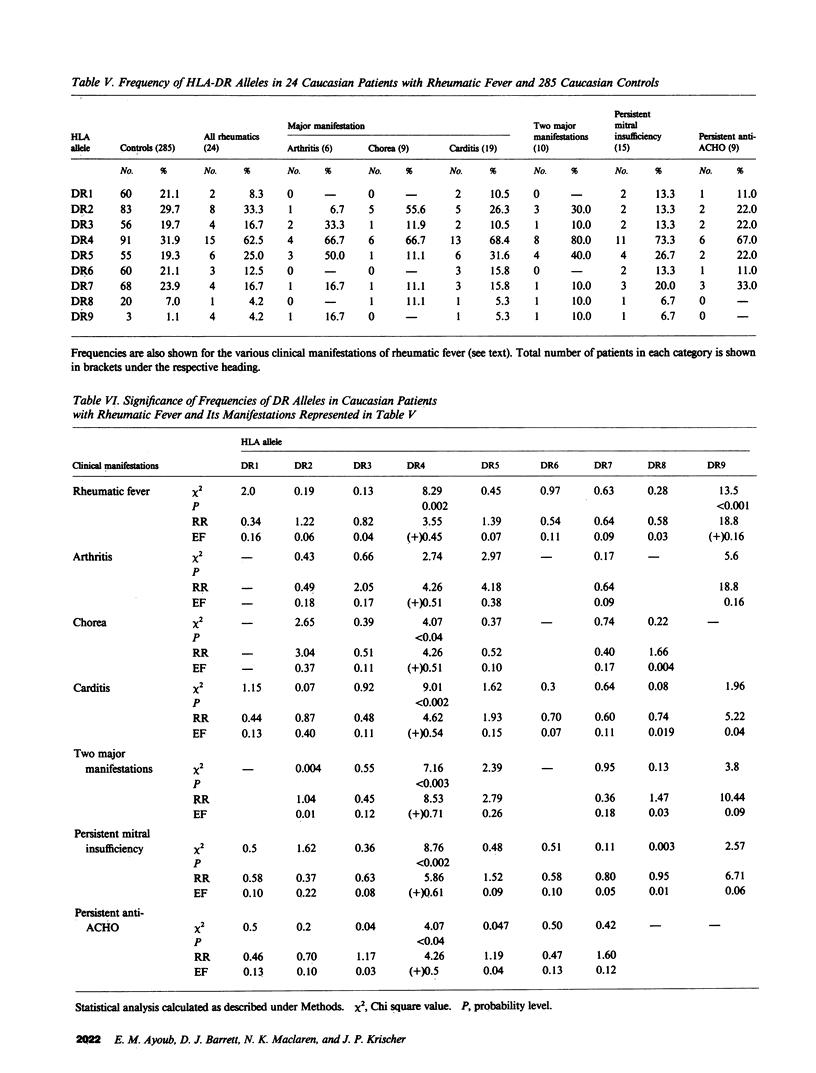
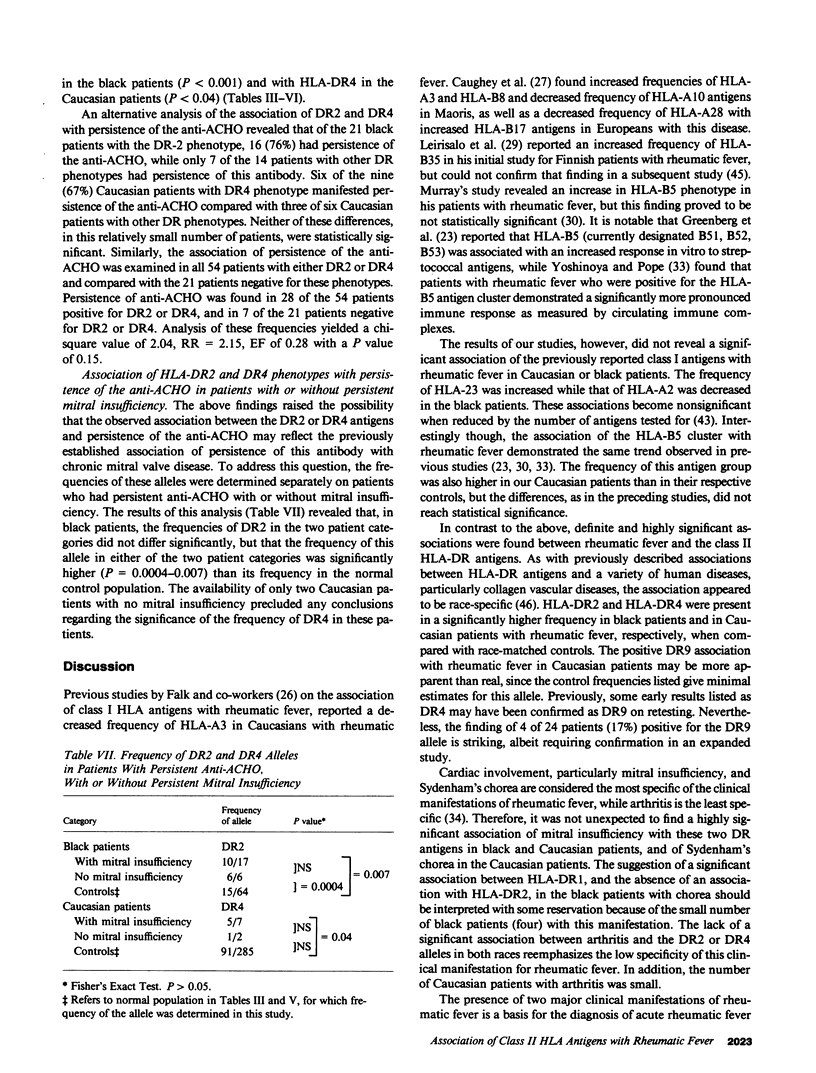
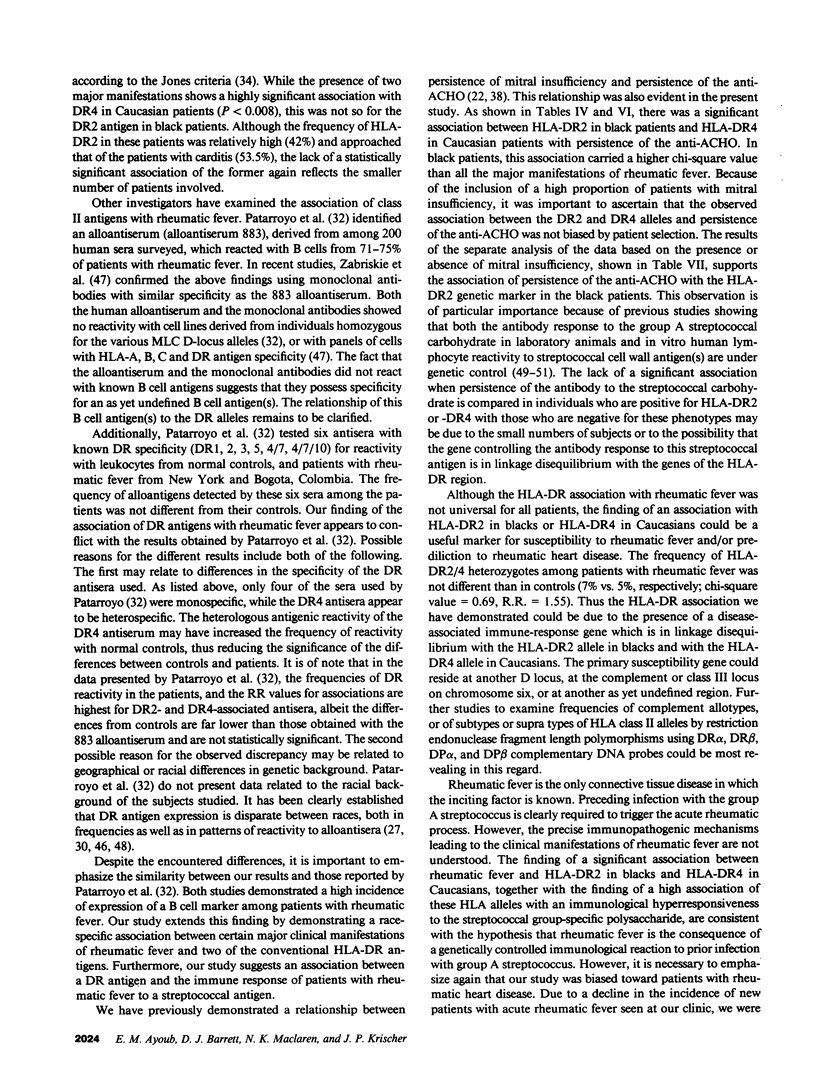
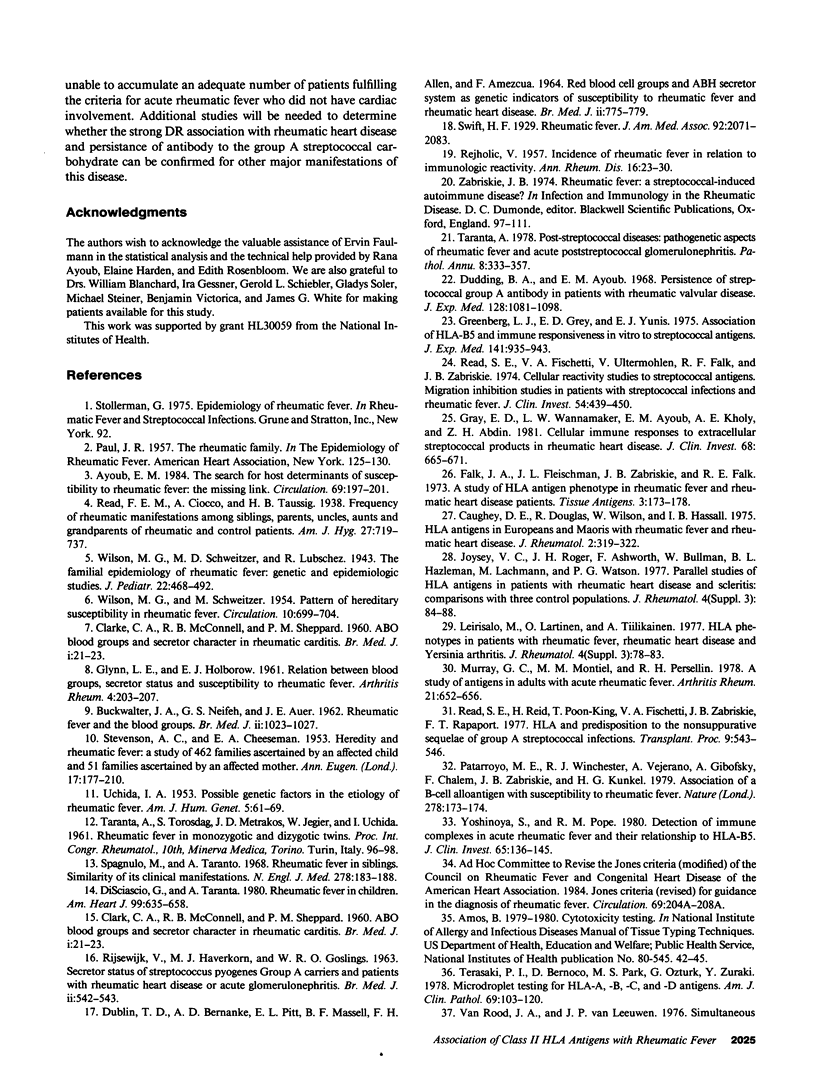
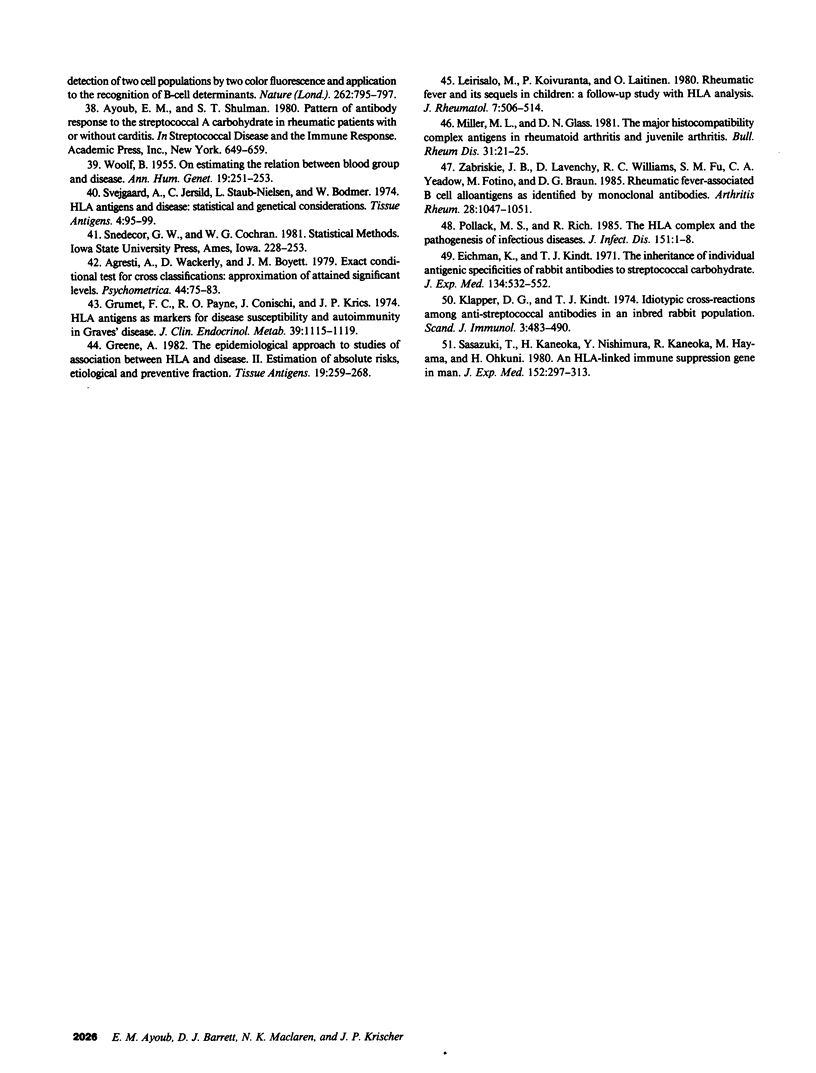
Selected References
These references are in PubMed. This may not be the complete list of references from this article.
- Ayoub E. M. The search for host determinants of susceptibility to rheumatic fever: the missing link. T. Duckett Jones Memorial Lecture. Circulation. 1984 Jan;69(1):197–201. doi: 10.1161/01.cir.69.1.197. [DOI] [PubMed] [Google Scholar]
- BUCKWALTER J. A., NAIFEH G. S., AUER J. E. Rheumatic fever and the blood groups. Br Med J. 1962 Oct 20;2(5311):1023–1027. doi: 10.1136/bmj.2.5311.1023. [DOI] [PMC free article] [PubMed] [Google Scholar]
- CLARKE C. A., McCONNELL R. B., SHEPPARD P. M. ABO blood groups and secretor character in rheumatic carditis. Br Med J. 1960 Jan 2;1(5165):21–23. doi: 10.1136/bmj.1.5165.21. [DOI] [PMC free article] [PubMed] [Google Scholar]
- CLARKE C. A., McCONNELL R. B., SHEPPARD P. M. ABO blood groups and secretor character in rheumatic carditis. Br Med J. 1960 Jan 2;1(5165):21–23. doi: 10.1136/bmj.1.5165.21. [DOI] [PMC free article] [PubMed] [Google Scholar]
- Caughey D. E., Douglas R., Wilson W., Hassall I. B. HL-A antigens in Europeans and Maoris with rheumatic fever and rheumatic heart disease. J Rheumatol. 1975 Sep;2(3):319–322. [PubMed] [Google Scholar]
- DUBLIN T. D., BERNANKE A. D., PITT E. L., MASSELL B. F., ALLEN F. H., Jr, AMEZCUA F. RED BLOOD CELL GROUPS AND ABH SECRETOR SYSTEM AS GENETIC INDICATORS OF SUSCEPTIBILITY TO RHEUMATIC FEVER AND RHEUMATIC HEART DISEASE. Br Med J. 1964 Sep 26;2(5412):775–779. doi: 10.1136/bmj.2.5412.775. [DOI] [PMC free article] [PubMed] [Google Scholar]
- DiSciascio G., Taranta A. Rheumatic fever in children. Am Heart J. 1980 May;99(5):635–658. doi: 10.1016/0002-8703(80)90739-5. [DOI] [PubMed] [Google Scholar]
- Dudding B. A., Ayoub E. M. Persistence of streptococcal group A antibody in patients with rheumatic valvular disease. J Exp Med. 1968 Nov 1;128(5):1081–1098. doi: 10.1084/jem.128.5.1081. [DOI] [PMC free article] [PubMed] [Google Scholar]
- Eichmann K., Kindt T. J. The inheritance of individual antigenic specificities of rabbit antibodies to streptococcal carbohydrates. J Exp Med. 1971 Aug 1;134(2):532–552. doi: 10.1084/jem.134.2.532. [DOI] [PMC free article] [PubMed] [Google Scholar]
- Falk J. A., Fleischman J. L., Zabriskie J. B., Falk R. E. A study of HL-A antigen phenotype in rheumatic fever and rheumatic heart disease patients. Tissue Antigens. 1973;3(3):173–178. doi: 10.1111/j.1399-0039.1973.tb00991.x. [DOI] [PubMed] [Google Scholar]
- GLYNN L. E., HOLBOROW E. J. Relation between blood groups, secretor status and susceptibility to rheumatic fever. Arthritis Rheum. 1961 Apr;4:203–207. doi: 10.1002/art.1780040210. [DOI] [PubMed] [Google Scholar]
- Gray E. D., Wannamaker L. W., Ayoub E. M., el Kholy A., Abdin Z. H. Cellular immune responses to extracellular streptococcal products in rheumatic heart disease. J Clin Invest. 1981 Sep;68(3):665–671. doi: 10.1172/JCI110301. [DOI] [PMC free article] [PubMed] [Google Scholar]
- Green A. The epidemiologic approach to studies of association between HLA and disease. II. Estimation of absolute risks, etiologic and preventive fraction. Tissue Antigens. 1982 Apr;19(4):259–268. doi: 10.1111/j.1399-0039.1982.tb01450.x. [DOI] [PubMed] [Google Scholar]
- Greenberg L. J., Gray E. D., Yunis E. J. Association of HL-A 5 and immune responsiveness in vitro to streptococcal antigens. J Exp Med. 1975 May 1;141(5):935–943. doi: 10.1084/jem.141.5.935. [DOI] [PMC free article] [PubMed] [Google Scholar]
- Grumet F. C., Payne R. O., Konishi J., Kriss J. P. HL-A antigens as markers for disease susceptibility and autoimmunity in Graves' disease. J Clin Endocrinol Metab. 1974 Dec;39(6):1115–1119. doi: 10.1210/jcem-39-6-1115. [DOI] [PubMed] [Google Scholar]
- HAVERKORNVAN RIJSEWIJK, GOSLINGS W. R. SECRETOR STATUS OF STREPTOCOCCUS PYOGENES GROUP A CARIERS AND PATIENTS WITH RHEUMATIC HEART DISEASE OR ACUTE GLOMERULONEPHRITIS. Br Med J. 1963 Aug 31;2(5356):542–543. doi: 10.1136/bmj.2.5356.542. [DOI] [PMC free article] [PubMed] [Google Scholar]
- Joysey V. C., Roger J. H., Ashworth F., Bullman W., Hazleman B. L., Lachmann S. M., Watson P. G. Parallel studies of HLA antigens in patients with rheumatic heart disease and scleritis: comparisons with three control populations. J Rheumatol Suppl. 1977;3:84–88. [PubMed] [Google Scholar]
- Klapper D. G., Kindt T. J. Idiotypic cross-reactions among anti-streptococcal antibodies in an inbred rabbit population. Scand J Immunol. 1974;3(4):483–490. doi: 10.1111/j.1365-3083.1974.tb01281.x. [DOI] [PubMed] [Google Scholar]
- Leirisalo M., Kovuranta P., Laitinen O. Rheumatic fever and its sequels in children. A follow-up study with HLA analysis. J Rheumatol. 1980 Jul-Aug;7(4):506–514. [PubMed] [Google Scholar]
- Leirisalo M., Laitinen O., Tiilikainen A. HLA phenotypes in patients with rheumatic fever, rheumatic heart disease, and Yersinia arthritis. J Rheumatol Suppl. 1977;3:78–83. [PubMed] [Google Scholar]
- Miller M. L., Glass D. N. The major histocompatibility complex antigens in rheumatoid arthritis and juvenile arthritis. Bull Rheum Dis. 1981;31(5):21–25. [PubMed] [Google Scholar]
- Murray G. C., Montiel M. M., Persellin R. H. A study of HLA antigens in adults with acute rheumatic fever. Arthritis Rheum. 1978 Jul-Aug;21(6):652–656. doi: 10.1002/art.1780210607. [DOI] [PubMed] [Google Scholar]
- Patarroyo M. E., Winchester R. J., Vejerano A., Gibofsky A., Chalem F., Zabriskie J. B., Kunkel H. G. Association of a B-cell alloantigen with susceptibility to rheumatic fever. Nature. 1979 Mar 8;278(5700):173–174. doi: 10.1038/278173a0. [DOI] [PubMed] [Google Scholar]
- Pollack M. S., Rich R. R. The HLA complex and the pathogenesis of infectious diseases. J Infect Dis. 1985 Jan;151(1):1–8. doi: 10.1093/infdis/151.1.1. [DOI] [PubMed] [Google Scholar]
- REJHOLEC V. Incidence of rheumatic fever in relation to immunologic reactivity. Ann Rheum Dis. 1957 Mar;16(1):23–30. doi: 10.1136/ard.16.1.23. [DOI] [PMC free article] [PubMed] [Google Scholar]
- Read S. E., Fischetti V. A., Utermohlen V., Falk R. E., Zabriskie J. B. Cellular reactivity studies to streptococcal antigens. Migration inhibition studies in patients with streptococcal infections and rheumatic fever. J Clin Invest. 1974 Aug;54(2):439–450. doi: 10.1172/JCI107780. [DOI] [PMC free article] [PubMed] [Google Scholar]
- Read S. E., Reid H., Poon-King T., Fischetti V. A., Zabriskie J. B., Rapaport F. T. HLA and predisposition to the nonsuppurative sequelae of group A streptococcal infections. Transplant Proc. 1977 Mar;9(1):543–546. [PubMed] [Google Scholar]
- STEVENSON A. C., CHEESEMAN E. A. Heredity and rheumatic fever; a study of 462 families ascertained by an affected child and 51 families ascertained by an affected mother. Ann Eugen. 1953 Feb;17(3):177–210. doi: 10.1111/j.1469-1809.1953.tb02546.x. [DOI] [PubMed] [Google Scholar]
- Spagnuolo M., Taranta A. Rheumatic fever in siblings. Similarity of its clinical manifestations. N Engl J Med. 1968 Jan 25;278(4):183–188. doi: 10.1056/NEJM196801252780403. [DOI] [PubMed] [Google Scholar]
- Svejgaard A., Jersild C., Nielsen L. S., Bodmer W. F. HL-A antigens and disease. Statistical and genetical considerations. Tissue Antigens. 1974;4(2):95–105. doi: 10.1111/j.1399-0039.1974.tb00230.x. [DOI] [PubMed] [Google Scholar]
- Taranta A. Poststreptococcal diseases: pathogenetic aspects of rheumatic fever and acute poststreptococcal glomerulonephritis. Pathobiol Annu. 1978;8:333–357. [PubMed] [Google Scholar]
- Terasaki P. I., Bernoco D., Park M. S., Ozturk G., Iwaki Y. Microdroplet testing for HLA-A, -B, -C, and -D antigens. The Phillip Levine Award Lecture. Am J Clin Pathol. 1978 Feb;69(2):103–120. doi: 10.1093/ajcp/69.2.103. [DOI] [PubMed] [Google Scholar]
- UCHIDA I. A. Possible genetic factors in the etiology of rheumatic fever. Am J Hum Genet. 1953 Mar;5(1):61–69. [PMC free article] [PubMed] [Google Scholar]
- WILSON M. G., SCHWEITZER M. Pattern of hereditary susceptibility in rheumatic fever. Circulation. 1954 Nov;10(5):699–704. doi: 10.1161/01.cir.10.5.699. [DOI] [PubMed] [Google Scholar]
- WOOLF B. On estimating the relation between blood group and disease. Ann Hum Genet. 1955 Jun;19(4):251–253. doi: 10.1111/j.1469-1809.1955.tb01348.x. [DOI] [PubMed] [Google Scholar]
- Yoshinoya S., Pope R. M. Detection of immune complexes in acute rheumatic fever and their relationship to HLA-B5. J Clin Invest. 1980 Jan;65(1):136–145. doi: 10.1172/JCI109643. [DOI] [PMC free article] [PubMed] [Google Scholar]
- Zabriskie J. B., Lavenchy D., Williams R. C., Jr, Fu S. M., Yeadon C. A., Fotino M., Braun D. G. Rheumatic fever-associated B cell alloantigens as identified by monoclonal antibodies. Arthritis Rheum. 1985 Sep;28(9):1047–1051. doi: 10.1002/art.1780280912. [DOI] [PubMed] [Google Scholar]


